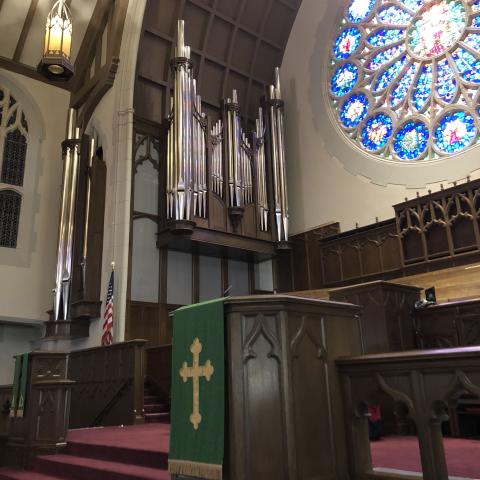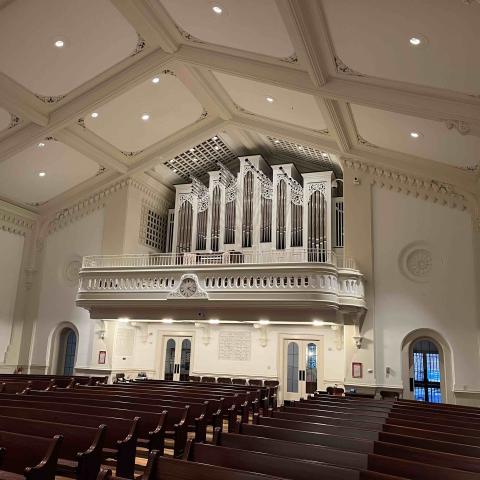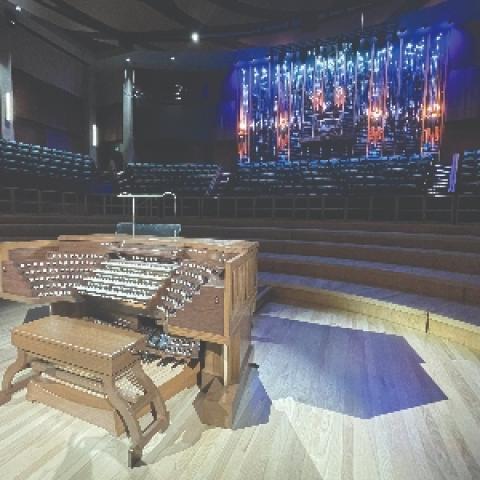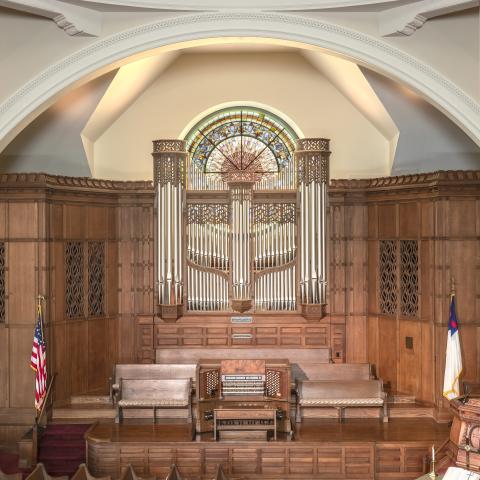Orgues Létourneau, Saint-Hyacinthe, Québec; Christ Episcopal Church, Tuscaloosa, Alabama
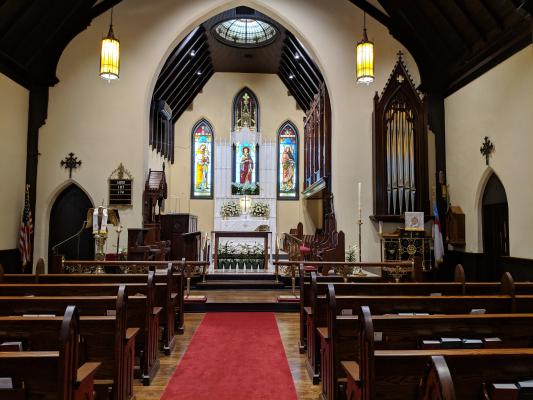
From the Builder
It is unusual for an organbuilder to finish two instruments for churches a few blocks apart within two calendar years. Nonetheless, this is what happened in Tuscaloosa, Alabama, and we consider ourselves fortunate to say so. The first of these was our Opus 129 for First Presbyterian Church, which we completed in January 2016 (see the May 2017 issue of The Diapason for more details). This 75-rank instrument’s warmth and array of color piqued the interest of the organ committee at the nearby Christ Episcopal Church. Led by Mr. Wilson Green, this committee was already studying what to do with the church’s ailing pipe organ. Having been serially rebuilt without success, its indifferent placement in Christ Church’s organ chamber was its biggest challenge. The instrument’s monochromatic tonal scheme and obsolete windchests were contributing factors in the decision to start from scratch and commission an all-new pipe organ.
An organ chamber like that at Christ Church does require a change in mindset from, say, a freestanding instrument like Opus 129. Here, there is a wide floor-to-ceiling opening across the chancel’s south sidewall into the chamber. A smaller arch-shaped opening on the chamber’s west wall leads to the nave. The chamber’s wooden roof slopes downward moving west (away from the chancel), which dictated some aspects of the organ’s layout, but the side and back walls in brick do reflect sound out of the chamber nicely.
Christ Church’s organ committee was unambiguous; they wanted an instrument that would excel in accompanying the Episcopal liturgy. This fit, in many ways, with the organ’s placement in a chamber. The emphasis here would be a profusion of smooth foundation color, elegant solo voices, and choruses in all families of organ tone, all backed by exceptional dynamic control. The organ’s repertoire was kept in mind of course, but this instrument’s raison d’être was always going to be the choral anthems of Howells, Parry, and Stanford.
Carefully studying the chamber, we determined there was enough space for a three-manual instrument; two of the three manual divisions would be under expression at the back of the chamber, with space to spare in front for lean Great and Pedal divisions. Working with the church’s then-organist and assistant director of music, Tyler Canonico, Opus 132’s stoplist soon took shape.
The Swell forms the core of the instrument with foundations including a pungent 8′ Viole de gambe, a matching 8′ Voix Celeste, a gentle 16′ Lieblich, and a velvety 8′ Dolce Flute and Celeste combination. Building on this is a solitary 4′ stop, the Gemshorn; its scale transitions from a principal-like bass for definition towards a fluty treble to blend with the mutations. A refined 8′ Hautboy with capped resonators can add a reedy tang to this ensemble or sing as a mezzo solo voice. One dynamic higher is the Swell’s 8′ cornet décomposé, whose wide-scaled tapered ranks fuse together richly. With choral accompaniment in mind, the Swell’s III–V Full Mixture is harmonic in composition, meaning its uppermost pitch is constant through most of the compass while the fourth and fifth ranks add lower pitches to fill in the chorus. The Swell is crowned by a grand reed chorus that begins, crucially, with a full-length 16′ Double Trumpet through an 8′ Cornopean to a 4′ Clarion. On five inches of wind pressure, these stops feature thick spotted metal resonators, harmonic trebles, and Willis-style shallots. This powerful, golden-toned chorus can also be transferred as a group from the Swell to the other divisions via stopknobs to facilitate dynamic effects.
The second expressive division, the Choir-Solo, is something of a partner to the Great with additional foundation stops and distinctive solo voices. The 8′ Flûte harmonique isn’t a thoroughgoing solo stop so much as it is a building block in a traditional fonds ensemble when coupled to the Great. Building on this 8′, the vibrant 4′ and 2′ harmonic flutes provide a lighter chorus to their equivalent Great combination. The 8′ Geigen brings a keen edge to the fonds, while its 16′ extension provides depth and richness without getting muddy. The 16′ Geigen’s clean pitch and responsiveness in the bass octaves is especially welcome when deployed as a pedal stop. Meanwhile, the 8′ Unda maris pairs with the 8′ Geigen to provide the organ’s third and boldest celeste effect. The Choir-Solo has two high-pressure reed stops. The 8′ French Horn was a request from Christ Church’s rector, the Rev. David Meginniss, and given its rare appearances in choral accompaniments or the organ repertoire—as well as the limited tessitura called for—we built it as a short-compass stop from c13 to f42. On high-pressure wind at the back of the Choir-Solo enclosure, the French Horn projects its fist-in-the-bell sound easily, evoking its orchestral ancestor. Its thick, smooth tone can be used to bulk up ensemble registrations, but it pairs especially well with the 8′ Flûte harmonique with the treble-ascendant flute picking up smoothly where the French Horn’s compass runs out.
The Choir-Solo’s 16′-8′ Tuba rank’s harmonic-length resonators begin at 4′ g, and the pipes are equipped with tapered Willis shallots for proper tuba tone. The overall dynamic, however, is kept in check. On 12¾ inches wind like the French Horn, the Tuba rank serves as solo stop or the ultimate chorus reed: it will peal out a melody against Full Swell—especially when played in octaves as asked for in much of the literature—but can be thrown in to otherwise Full Organ without a colossal dynamic jump. The 16′ Contra Tuba extension in the Pedal has a big, round bass tone that ensures the instrument never sounds untethered.
In contrast to these two colorful expressive divisions, the Great has been stripped down to the essentials. There is a warm principal chorus built around a 42-scale 8′ Open Diapason, with the Great windchest situated to face the nave’s tone opening. The 8′ Chimney Flute is a cheery, chameleon-like voice that does light solo duty or plumps up the ensemble. For flexibility, a number of stops from the Choir-Solo have also been made available on the Great manual.
The Pedal division is like the Great: minimalist but effective. The 16′ Contrabass pipes are made from spotted metal and, voiced with slots and beards, give the pedal line a well-defined point. The 16′ Subbass, with its pipes in yellow poplar, is dynamically a notch lower with a correspondingly unobtrusive tone. Larger in scale than the Great 8′ Open, the 8′ Principal was also voiced with slots and on higher wind pressure; it has a bold, driven sound that fits with the Contrabass to give the pedal line a great deal of weight. Comparatively, the 4′ Choral Bass is less powerful with a sweeter, more transparent sound in cantus firmus roles.
When the contract was signed for the new instrument, the organ project at Christ Church had a fixed budget that precluded any façades. Likewise, some of the stops in the specification were initially console preparations, meaning they were part of the instrument’s technical designs but would not be provided with the instrument. The contract between the church and Létourneau was written such that if we were given the green light by a certain date, the façades and/or the prepared-for stops could be built and installed at the same time as the organ itself. The organ committee went to work raising the organ project’s profile and explaining the opportunity at hand to the parish. They were tremendously successful; the gifts they raised came from many sources and enabled the complete instrument to be installed. Once our visual designs had been enthusiastically approved, our cabinetmakers began construction on the instrument’s two façades made from solid mahogany. The display pipes are made from a 70% polished tin alloy from the Great 8′ Open Diapason and the Pedal 8′ Principal ranks.
The three-manual console shell was built from solid red oak while the interior puts swathes of dark walnut to good use. From the outset, the layout of the various console controls was a particular point of interest for Tyler Canonico and Wilson Green; many enjoyable discussions were had about the best practices from around the globe, and several different layouts were evaluated. The result is compact, logical, and comfortable. In a nod to the British tradition, the stop knobs for each division are arrayed in two columns and set within individual walnut jambs. The console’s expression shoes also mark the debut of a new style for Létourneau, featuring a pedal made from maple for durability and deeply stained to match the surrounding walnut. A chromed stainless-steel surface discreetly displaying the Létourneau logo is then overlaid on this base with rubber cleats for grip above and below. Opus 132’s switching system and combination action were provided by Solid State Organ Systems, with the console having 300 levels of memory, an adjustable crescendo pedal, and a generous number of divisional and general pistons (with a sequencer) to facilitate colorful accompanying.
The instrument was installed in January of 2018, and the voicing process carried through to the end of the following month. The instrument was dedicated at a choral evensong service on April 15, 2018, featuring the choir of Christ Church under music director Doff Procter, skillfully accompanied by Scott Roberts, organist and assistant music director. Before and after the service, several voluntaries were played by Tyler Canonico, who had returned to Tuscaloosa for the event; his selections included music by Bédard, Locklair, Howells, Bednall, Dupré, and Langlais.
Our Opus 132 is a sophisticated response to the host of physical, acoustic, and musical parameters this project presented. Importantly, the instrument contrasts significantly with the nearby Opus 129 at First Presbyterian Church, from placement to windchest design to tonal effect. For those who might be curious to see what Létourneau is doing these days, Tuscaloosa is a destination well worth visiting.
To conclude, we are grateful to Christ Church for having given us the opportunity to build Opus 132; we expect their new Létourneau will serve their church and the Tuscaloosa community faithfully for several future generations. Our work has given us the opportunity to come to know several fine people as well. We have a deep appreciation for the tireless leadership of Wilson Green throughout the entire project. It has also been a pleasure to work closely with the church’s two organists through the instrument’s gestation, Tyler Canonico and Scott Roberts, as well as the church’s director of music, Doff Procter. We are appreciative of the consistently generous support for the pipe organ project from Rev. David Meginniss. Christ Church’s communications director, Barbara Steimle, was also a tremendous supporter in countless ways. Finally, a sincere thank you to Hubert Guthrie, both the church’s contractor and a parishioner. His tenacious efforts to improve the organ chamber were crucial to the project’s success, resulting in the best possible acoustic conditions for the new instrument.
—Andrew Forrest, Artistic Director
Fernand Létourneau, President
Dudley Oakes, Project Consultant
From the Chair of the Organ Committee
We asked Létourneau to deliver an instrument that emphasized the organ’s central liturgical role in Episcopal worship, and they delivered beautifully. The organ is exceptional in enhancing and supplementing liturgical action, as well as in service and congregational accompaniment. Having two celeste effects in the Swell, for example, was motivated by a desire to communicate the transcendent, and they accomplish this exceptionally. Putting most of the organ under expression, with a relatively small Great, was a decision largely driven by the church’s acoustics, which we altered before the organ’s installation began with changes to the nave floor and the chamber itself. The result is an instrument refined in tonal breadth and uniquely appropriate to the room.
The organ’s solo stops are not to be missed. The Choir-Solo 8′ Flûte harmonique has a body and smoothness that fill the room. The 8′ French Horn is one of my favorites, with a robust nobility and depth of tone with the box open, but which is quite mellow when enclosed. And the 8′ Tuba is powerful as a solo reed but it’s also capable of singing with the rest of the instrument—a rare combination, and one that was needed given the instrument’s size.
Létourneau was a wonderful partner for our church. Andrew Forrest and Dudley Oakes were particularly effective in listening to our concerns and making tonal recommendations tailored to those concerns. They explained their design choices and how they were intended both to enhance the listening experience in the room and to mitigate the lack of direct linearity with the listener. Communication was always clear and timely, and their sense of proportion and design afforded us an instrument that is musically and visually in tune with our historic space. The best compliment I receive is, “It looks like it was always there!” But honestly, it sounds even better. And perhaps most of all, the Létourneau installation and tonal finishing teams were magnificent. The church staff was sad to see them leave us when they finished!
—Wilson Green
GREAT – Manual II, 80 mm wind pressure
16′ Contra Geigen (Ch)
8′ Open Diapason (façade) 61 pipes
8′ Geigen (Ch)
8′ Chimney Flute 61 pipes
4′ Principal 61 pipes
2′ Fifteenth 61 pipes
11⁄3′ Mixture IV 244 pipes
Tremulant
8′ French Horn (Ch)
8′ Tuba (Ch)
Swell Reeds on Great
Great 16–Unison Off–Great 4
Chimes (Ch)
Cymbelstern (8 tuned bells)
SWELL (expressive), Manual III – 85 mm w.p.
16′ Lieblich Gedackt 73 pipes
8′ Viole de Gambe 61 pipes
8′ Voix Celeste (G8) 54 pipes
8′ Lieblich Gedackt (ext)
8′ Dolce Flute 61 pipes
8′ Flute Celeste (C13) 49 pipes
4′ Gemshorn 61 pipes
22⁄3′ Nazard 61 pipes
2′ Flageolet 61 pipes
13⁄5′ Tierce 61 pipes
2′ Full Mixture III–V 259 pipes
8′ Hautboy 61 pipes
Tremulant
16′ Double Trumpet* 61 pipes
8′ Cornopean* 66 pipes
4′ Clarion* 78 pipes
Swell 16–Unison Off–Swell 4
* 125 mm wind pressure
CHOIR-SOLO (expressive) Manual I – 125 mm w.p.
16′ Contra Geigen 73 pipes
8′ Flûte harmonique 61 pipes
8′ Geigen (ext)
8′ Unda maris (G8) 54 pipes
4′ Flûte octaviante 61 pipes
2′ Octavin 61 pipes
8′ Clarinet 61 pipes
Tremulant
8′ French Horn (c13–f42)§ 30 pipes
8′ Tuba§ 66 pipes
Swell Reeds on Choir
Choir 16–Unison Off–Choir 4
Chimes (37 notes)†
Harp (61 notes)†
Glockenspiel (37 notes)†
§ 325 mm wind pressure
† Walker Technical Company
PEDAL – 110 mm w.p.
32′ Resultant (derived)
16′ Contrabass 32 pipes
16′ Bourdon 32 pipes
16′ Geigen (Ch)
16′ Lieblich Gedackt (Sw)
8′ Principal (façade) 32 pipes
8′ Lieblich Gedackt (Sw)
4′ Choral Bass (85mm) 32 pipes
16′ Contra Tuba (ext, Ch) 12 pipes
8′ Tuba (Ch)
Swell Reeds on Pedal
All usual sub, unison, and octave inter-manual couplers plus Great to Choir, Choir to Swell, and a GR-CH Manual Transfer.
6 divisional pistons for each division and 12 General pistons with a General piston sequencer.
Console prepared for the future installation of a 5-stop Antiphonal division.
Three manuals, 43 stops, 38 ranks, 2,162 pipes
Great Mixture IV
c1 to b12 19 22 26 29
c13 to b24 15 19 22 26
c25 to b36 12 15 19 22
c37 to b48 8 12 15 19
c49 to c61 5 8 12 15
Swell Full Mixture III–V
c1 to e17 15 19 22
f18 to e29 12 15 19 22
f30 to e41 8 12 15 19 22
f42 to e53 1 8 12 15 19
f54 to c61 1 5 8 12 15
Photo credits: Barbara Steimle

